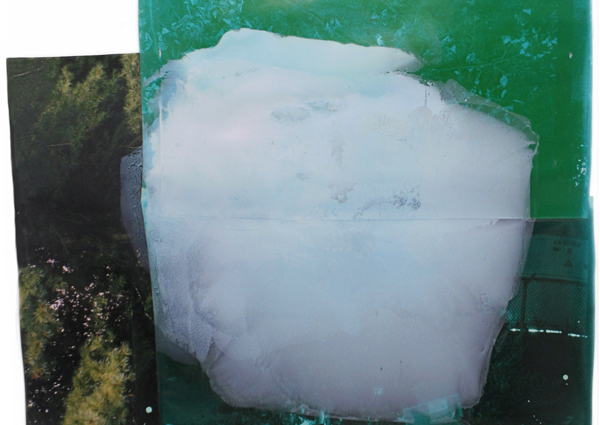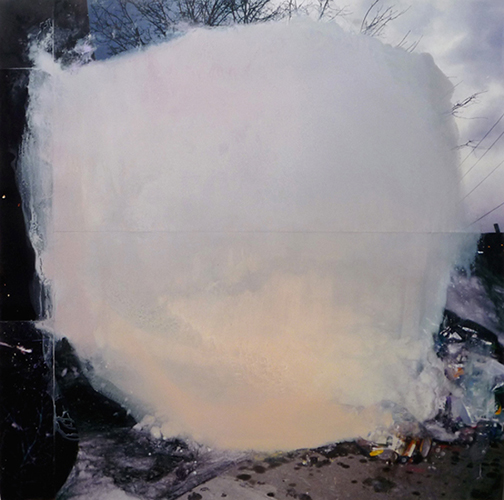
When I first met Brooklyn-based visual artist Claire Falkenberg in the fall of 2014 at the Ucross Foundation, she struck me as just what our little group of resident artists needed: a funny, candid, and disarmingly intelligent voice of reason. When we griped and moaned about the sluggish progress some of us were having with our own endeavors, while gawking at the ease with which others seemed to produce work, she was quick to remind us all that “art is not a competition,” but rather a process of “slow, continual observation.” With Falkenberg’s advice in mind I stopped worrying so much about rushing to pound out the next section of my novel and started paying more attention to how, on the walk to my studio each morning, the tawny Wyoming hills stretched about me like a worn hide.
Falkenberg’s multimedia works—large-scale photo and oil paint collages and, more recently, paintings constructed of scrap wood, cardboard, and semitransparent paper—reflect her tendency toward unhurried observation. Her painted-over photographs, such as “Conifers,” “Pine,” and “New Day” (collaged prints of trees, sidewalks, and trash almost entirely obscured under clouds of oil paint), have been described as mystifying and ominous: images that compel the viewer to examine the ethereal layers beyond the nearly opaque surfaces, provoking feelings of disorientation and wonder. Her work has been shown throughout the US and Canada, including at Big Medium Gallery and Champion Contemporary in Austin, Dose Projects Space in Brooklyn, Katharine Mulherin Contemporary Art Projects in Toronto, and Inman Gallery in Houston.
Falkenberg describes her own artistic process as one of seeking “the familiar within the unknown, and the unknown within the familiar…looking to recognize [oneself] as not separate from the landscape but within it as equal, contingent, and mysterious.” There is a great sense of presence about her pieces. They are commanding and abstract, glowing sculptural shapes and photos summoned from under still pools of paint. They are representational in the manner of something out of a fever-haze, or that moment when you wake and feel that you can perfectly recall a dream only to find, when you go to talk about it, that it has slipped away.
Of her most recent work, sculptural pieces such as “Lover,” “Evening,” “Blush,” and “Black night,” she writes, “before they are recognized as tenuous paper paintings, I want the work to first provoke a sensation, a feeling before words, names or stories, a deep and subtle sense that causes us to wonder—what is this thing, and how do I already know it?”
While at Ucross, Falkenberg and I began many conversations about those things that come before names or stories, about familiarity and landscapes, light and trees. I was thrilled to be able to continue those talks recently, and during them to think ever more deeply about my relationship to the land and my own artistic process.
—Mesha Maren for Guernica
Guernica: I am curious about the various elements that make up your pieces. Can you talk a little bit about how you create both your photo collages and paper sculptures?
Claire Falkenberg: I walk around and look at things—trees, bushes, trash, clouds—and sometimes take photos. Sometimes I use the photos and sometimes I don’t, or maybe I will come back to them after a period of time. I shoot with a little 35mm automatic camera and get 5×7 prints made of the whole roll. I guess it’s like sketching or note-taking. When I was making the collages, I would choose from the 5×7 photos and make them into big prints in a color darkroom, as big as I could. Back in the studio I would then collage them together—upside down, right side up, winter, summer, night, day. Working with them flat on the floor, I would pour large pools of thinned-out oil paint on top of the glued-together photos, rolling the color around to make a blob-like cloud shape. Never using brushes, I would move the paint around by lifting up the edges of the print. Sometimes I would pull the collage apart, swap out a photo that wasn’t working and glue it back together again, cut sections off, maybe glue them back on. Looking at it on the wall, I would turn it around, turning it in all directions, looking for the shape to make sense. The works have a real physicality to them—they are quite dinged up, there are patched rips and little tears around the edges and buckling where the photos have been glued together.
The process of the newer work—the half-sculpture, half-painting, constructed pieces—is similar in many ways. They are made with scrap wood and salvaged cardboard—often that has been found on the street—and different types of paper. Again, I work with it flat on the floor, roughly painting the shape with tempera, latex, and acrylic paint. Looking at it up on the wall, with the glassine over the top, I turn it in all directions, looking for the shape to make sense, crunching the edges of the paper and gluing pieces onto the structure to change the shape. In both cases—with the photo-based work and the constructed paintings—the process is quite loose and quite rough. It’s a lot of looking and looking and looking, trying to see the thing that is taking shape.
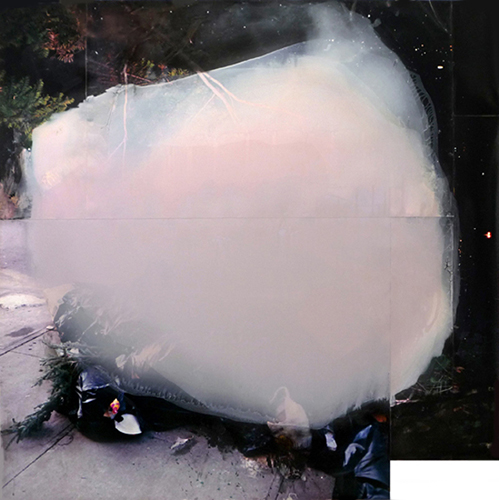
Guernica: At an artist talk that I heard you give at the Ucross Foundation, you mentioned that you once had a studio visitor who said that your work, specifically “Conifers,” made him feel as if you were pushing a pillow in his face and he could just barely see around it. You said that though this was meant as a sort of criticism, it also perfectly described what you are trying to do with your photo-based pieces, namely to disorient the viewer and cause them to see the world around them in a new way. While your art is landscape-based, it is also so much about immediate experience and unknowing. Can you talk a little bit about the role that landscape plays in your work?
Claire Falkenberg: I am interested in the familiarity of the landscape as well as the total mysteriousness of it. I am interested in spaces, things, and sensations that are somehow known but are not necessarily paid attention to. I use the landscape, or a feeling of a landscape, to both ground the work in some sort of physical reality and as a counterpoint from which to describe the unknowable and the mysterious. Through my work I’m trying to place myself within the landscape, and it within me. It’s a very intimate and sensual relationship. I like that “Conifers” felt like a pillow being pushed into the face because it is such a visceral response. It’s as if there is this thing, this very obvious thing right in front of you—right there, pushing into you—and it’s so obvious it’s hard to see.
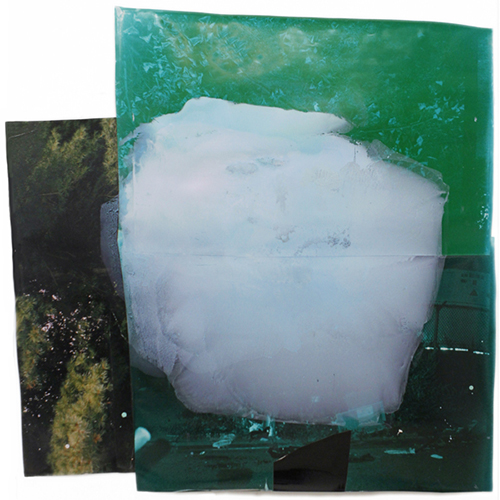
Guernica: I love that idea of the intimacy of landscapes we look at but don’t really see. I just finished reading Maggie Nelson’s The Argonauts, and in that text she talks a lot about what she calls “unnameable things” or “things whose essence is flicker, flow.” She talks about how when we think we can recognize or name something it changes our interaction with that thing. We strive to fit it into the mold of the “knowable,” but when something is unrecognizable it has a different energy. I think that it is precisely that energy that electrifies your art. When I look at a work like “Pine,” there is an intense activeness there that comes from the fact of my eye roving the painting, searching for focus and familiarity, and creating, out of the disorienting image, a completely new thing. I think that your work demands a certain level of vulnerability from the viewer, the vulnerability that comes with not knowing, not recognizing.
Claire Falkenberg: I think vulnerability and provoking a sense of vulnerability is quite an important aspect to my work. I want the pieces to feel like something more so than look like something. The difference is very specific. My intent in provoking a sensation is to make the work disarming, to make the work and the viewer vulnerable to one another. In this disarmament my hope is that the work is experienced as a present and unfolding sensation, something that is happening right here before you, with you, to you, an experience that is both mysterious and lucid, something that is very, very tenuous. I find there is a feeling in the photo-based work that is quite demanding. The painted shapes are these figures that simultaneously pull you close and push you away. They hold you. In the newer work, the paper constructed pieces, I feel that it is much more necessary that you meet them halfway, that you go to them and let them come to you. They don’t look like much unless you open yourself to them. And this thing that happens, this sensation that arises, it takes place somewhere in the middle.
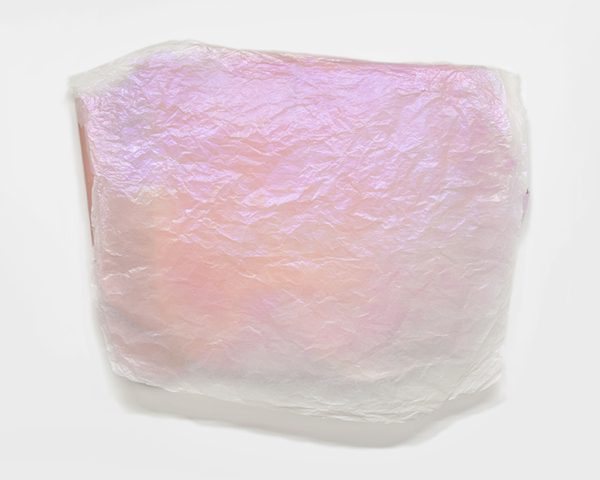
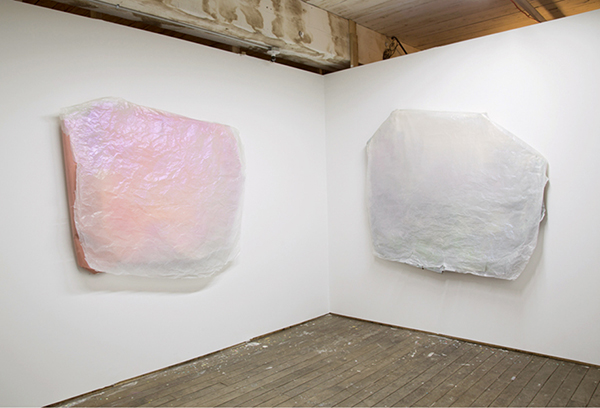
Guernica: We’ve talked before about how the place you were raised in has heavily influenced your work: rural southern Ontario, in Canada.
Claire Falkenberg: Yes, for sure. I grew up in the same house that my parents still live in today and I think that so much of my sensibility has come from returning to and looking at that same landscape over and over. My family’s property itself has changed tremendously over time—trees and buildings have been moved, the ground re-shaped, the forest grew in, big trees came down—it has changed a lot. It looks very different from when I was a kid. But the immediate surrounding landscape, the neighbors’ fields and forests, the slope of the land, the dirt road the house is on, these things have not changed very much at all. I have spent a lot of time walking down the road and going up into the fields, lying down in the sunshine on the grass or the snow and looking out across the valley. I think this looking and looking at the shapes of things, at the colors, at the light, at the familiarity of it all, this feeling of knowing the landscape yet continually returning to it—really looking at it and feeling it—this affects everything I make. It is not rooted in nostalgia or memory or longing but very much in a desire to feel like a thing within the landscape, a thing that is of the landscape, something that is here right now, very present.
Guernica: I like the distinction that you are making between nostalgia and present awareness, an awareness of what it means to see something over and over again but still try to see it as it is right now. I was speaking to a West Virginia poet, Justin Wymer, recently and we were talking about the influence of the land on our work. He said something like, “Do you think I’ll ever be able to write a poem that’s not about a leaf?” And it made me think, can we as artists grow past these influences, or should we even try?
Claire Falkenberg: I think all we can do is make the thing that is inside of us. And that thing, whatever it is, we need to pay attention to it. We can’t ignore it and try to make something different, or fall asleep and just make the same thing again and again. I think that the object or the poem or the relationship that is made, whatever it is, is only the by-product of this paying attention.
Guernica: And this “paying attention” involves, for you, both a certain familiarity and freshness? A sort of cumulative awareness of how a landscape was and how it is in every new moment?
Claire Falkenberg: Yes, like that, and beyond the landscape as well. For me I think it is trying to be as objective as possible while at the same time remaining vulnerable and empathetic. Like holding something in the palm of my hand while, at the same time, trying to be that very thing that is being held. What I want is for the works not to be dreamy or atmospheric or eerie or moving in any one particular direction toward one particular feeling. I really want them to hover in the middle of all these different things, and kind of sit at this balance point, just balancing, just barely. I think that if they are successful, they are left in a sort of indescribable spot. I think even calling them “clouds” or “cloud-like,” which I do, treads too close to a signpost and names the thing for us and starts walking us too close to dreamland. What I am trying to do is provoke a feeling or a sensation that is not really nameable.

Guernica: But though you want them to remain in an “indescribable spot,” the names of many of your pieces are very specific words that reference the natural world. What is your intent in choosing these titles?
Claire Falkenberg: I find titling things pretty tricky, but I think it is important and very helpful. It adds a whole other dimension. Sometimes I name the piece the most obvious thing, which in a lot of ways gives the viewer no clues, and other times the titles point toward something specific but not necessarily with an obvious reference to the piece. Mostly I am trying to not name the thing or describe it too much, but rather point to something else that could be similar. “Evening,” for example, feels like evening especially when it is suggested, but “Lover,” what does this mean? I like the foggy line that we try to make between the object, ourselves, the name of the thing, and the feeling it provokes; they connect and make sense only from one point to the next, but by the time we arrive back at the starting point, it’s not so clear any more. I use a lot of titles that are sort of “landscape-based” or have some sort of feel of a landscape because I want to situate the pieces in the outside world, in a somewhat neutral environment, somewhere that is familiar.
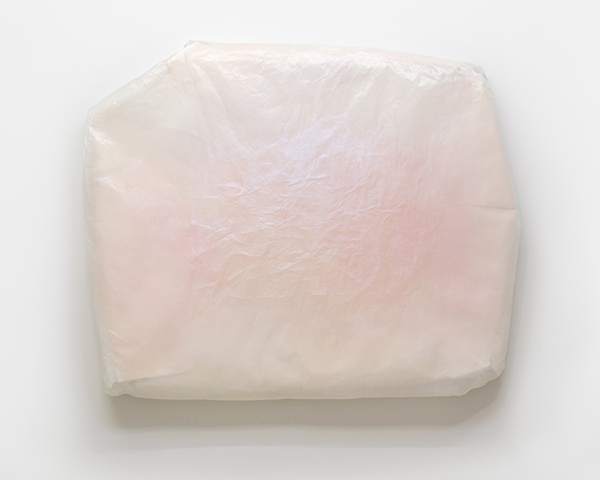
Guernica: Anne Carson, who is also from Ontario, writes in her poem “The Glass Essay” about traveling to visit her mother, and it feels to me as I read it that there is both inspiration and suffocation that comes from that home landscape:
my lonely life around me like a moor,
my ungainly body stumping over the mud flats with a look of transformation
that dies when I come in the kitchen door….
Well there are many ways of being held prisoner,
I am thinking as I stride over the moor.
As a rule after lunch mother has a nap
and I go out to walk.
The bare blue trees and bleached wooden sky of April
carve into me with knives of light.
Something inside it reminds me of childhood—
it is the light of the stalled time after lunch
when clocks tick
and hearts shut
and fathers leave to go back to work
and mothers stand at the kitchen sink pondering
something they never tell.
You remember too much,
my mother said to me recently.
Do you feel a push-pull relationship with your home landscape and the memory and association there?
Claire Falkenberg: I don’t have a push-pull relationship with my home landscape, not like that. It’s not weighed down with histories and memories and associations. I am very attached to my home landscape, but also I am not. I feel both like a newcomer to the land and also very much a part of it, like I am a billion-year-old stone. What resonates with me is the thing that comes before all of the stories and names and narratives. What I draw from is not exclusive to that particular space, those exact trees, or grasses. What resonates is the sense of the thing, the color, the light, the smell, the sound, these very specific sensations.
Guernica: In 2000, you exhibited your photo-based landscapes inside the Pickering Nuclear Generating Station, a nuclear power plant in Pickering, Ontario. Can you talk a little bit about this installation, the work in it, the images, and how the exhibit itself came to be?
Claire Falkenberg: I grew up about ten miles north of the Pickering nuclear plant, just beyond the suburban sprawl of Pickering and the greater Toronto area. As a kid, I watched this sprawl move east and north, eating up the farmland as it pushed out from the city. I watched as trees got bulldozed over, topsoil scraped into piles, roads put in, subdivision houses plunked on top, and box store after box store going up along the highways—all very typical of southern Ontario. I found this all very alienating and it very much affected my worldview, this endless, seemingly thoughtless consumption of the land. After I finished art school I moved home for a bit. At this time a friend was getting artists to show work in different local businesses and venues in the area and she introduced me to the nuclear plant. At first I didn’t want to be involved with the plant, and then I came to realize that actually this was the exact audience I was looking for. Initially I put some of my work into their visitors’ center and from that developed the idea of doing a larger project where I would produce new work with photos taken of the surrounding area and have the work installed inside the plant. I was awarded a grant from the Canada Council for the Arts for the project and made a series of eight photo paintings of these in-between spaces. The photos were a hybrid of real and unreal, half photo, half paint, with fiery light bursts and other phenomena in them. I hung them inside the nuclear plant on the tour route so people visiting the plant and the plant workers would come across them. My hope was that these strange yet familiar landscapes would be startling and provoke a visceral response, creating an opportunity for re-imagining the land and our relationship with it.

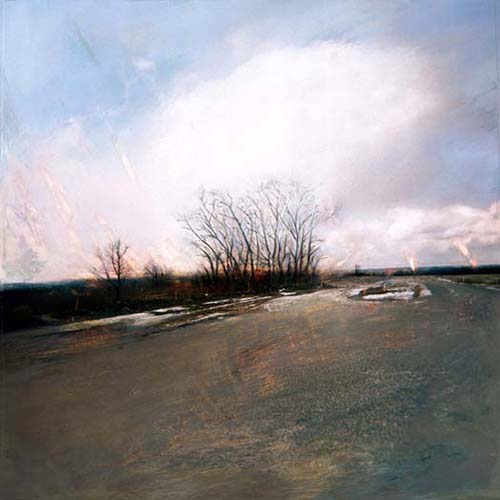
Guernica: When you say that the nuclear plant provided the “exact audience” that you were looking for, what do you mean? What sort of audience?
Claire Falkenberg: With that work I was really interested in communicating with an audience that was somehow engaged with the specific environments I was photographing, whether they were aware of them or not—just getting to the nuclear plant required driving through these half-rural, half-urban spaces. So the work became a mirror, in a sense, reflecting the surrounding landscape immediately back out to those who had just been in it, and who, upon leaving the plant, would again be passing through that same landscape. At that time I was interested in this very directed and specific experience.

Guernica: I feel that there is this movement in your work, from the earlier representational depictions of the natural world, with small “manmade” intrusions or aberrations, such as the telephone wires and flames and flashes of light, to larger aberrations in the form of the oil paint clouds in the photo collages, and finally to constructions of just the aberrations themselves in “Lights” and “Lover.” And then, it seems to me, the aberrations become less and less solid and curve back toward nature until they are almost representations of nature themselves.
Claire Falkenberg: It’s funny how these things go. When I first began to make the half-sculpture, half-painting constructed pieces, I was so mystified by them and thought they were a real departure from what I had been doing in the photo-based work. I couldn’t figure out where the shapes were coming from and why I was so compelled to make them. But clearly they are the shape in the photos, and they themselves are clouds and plastic bags and light and scrap materials—and yes, they somehow became representations of nature. I think that the farther along I come with my work, the more I am backing away from it, trying to let it be less directed.
My intention is always working toward making the thing as clear and as unembellished as possible, looking to reduce it down to the most essential, trying to get rid of any unnecessary information and at the same time stepping away from it, getting myself out of the way.
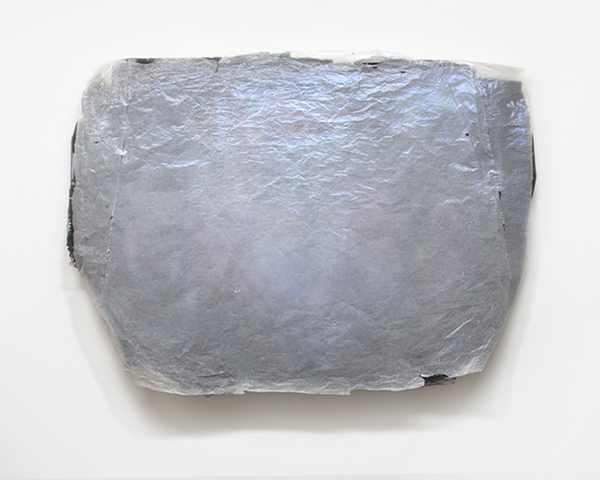
Mesha Maren is the author of the novel Sugar Run (forthcoming from Algonquin Books). Her work appears in Tin House and The Oxford American, among other literary journals, and she has been the recipient of fellowships from the MacDowell Colony and the Ucross Foundation.
To contact Guernica or Mesha Maren, please write here.

